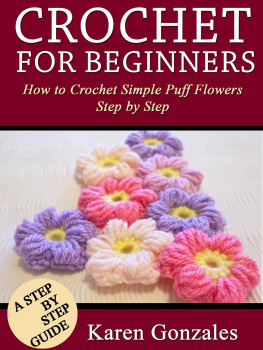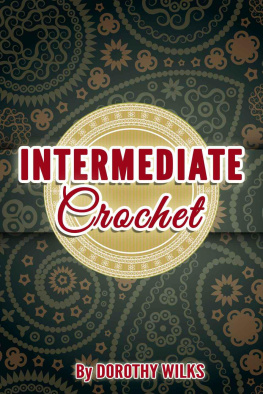Crochet For Beginners
Learn To Crochet Quickly & Easily Along With 15 Step-By-Step Patterns

Copyright 2015 By Kitty Moore
All rights reserved. No part of this book may be reproduced in any form without permission in writing from the author. No part of this publication may be reproduced or transmitted in any form or by any means, mechanic, electronic, photocopying, recording, by any storage or retrieval system, or transmitted by email without the permission in writing from the author and publisher.
For information regarding permissions write to author at Kitty@ArtsCraftsAndMore.com
Reviewers may quote brief passages in review.
Kitty Moore
ArtsCraftsAndMore.com
Introduction
Crochet is easy to learn and requires very little investment. You can accomplish a crochet project the first day you pick up a crochet hook!
There are many other reasons why crochet has become such a popular phenomenon.
- Its relaxing! You can crochet while you have a conversation, or while you watch television.
- Its portable! You can stick a crochet project in your pocket and take it wherever you go. Whenever youre waiting in a doctors office, at a school, or anywhere, you always have a project to keep yourself busy!
- Its expressive! You can utilize a variety of materials, colors, and stitches.
- Its personal! You can create gifts that are unique and individual.
- Its versatile! You can crochet with thin thread to make lace doilies or with a bulky yarn to make a warm hat or vest.
But wait, there is more!
- Crochet has a long history. Crocheted items were found in ancient China and along Arab trade routes.
- Crochet is also a contemporary art form. Yarn bombers around the world have crocheted cars, bicycles, fire hydrants, and signposts in cities and industrial areas.
- Crochet is scientific. Hyperbolic Crochet is the combination of crochet and mathematics. It is used to create models of the disappearing corals of the Great Barrier Reef around Australia, and to crochet replacement reefs from recycled trash.
Crochet is a dynamic skill! Learning to crochet can be a practical, useful activity. It might even begin a lifetime fascination with fashion, art, or mathematics.
Crochet Supplies
Learning to crochet requires very little initial investment. Start with the basic materials, and practice the beginning stiches. After you have mastered the fundamentals, you can investigate the huge variety of hooks, yarns and patterns that are available.
Crochet Hooks
- Crochet hooks come in a number of sizes and materials, but start simple.
- Use only one hook as you learn your first stitches and complete your first project.
- Start with an aluminium hook in size J.
Yarn
- Yarn also comes in a wide variety of weights and textures. Again, start simple.
- Choose a smooth, light-coloured yarn that will allow you to easily see your stitches.
- Select a heavy yarnlabelled worsted or chunky. It will be easier to handle.
Scissors
- A small, sharp pair of sewing scissors will be perfect.
Must Knows
Crochet Hooks
The size of the crochet hook determines the size of your stitches. A crochet pattern will call for a specific-sized hook, but sometimes the right sized hook is hard to find. That is because crochet hooks come in different sizes based on the material, brand and country where they were produced. A conversion tables can help you find the hook you need.
Crochet Hook Material
- Aluminium hooks are smooth and easy to use. They and available in a wide variety of sizes.
- Plastic hooks are light weight and also come in jumbo size.
- Bamboo hooks are available in many sizes and are light and warm.
- Steel hooks are usually small hooks used to crochet fine thread.
Crochet Yarn
Many fibers can be crocheted. Fibers are evaluated for seven qualities: absorbency, breathability, dye ability, softness, loft, resiliency and thickness. A pattern will usually suggest a specific yarn for a project. There are three categories of yarn fibers: plant fibers, animal fibers and synthetic fibers.
Read This FIRST - 100% FREE BONUS
FOR A LIMITED TIME ONLY Get Kittys best-selling book DYI Crafts: The 100 Most Popular Crafts & Projects That Make Your Life Easier absolutely FREE!
CLICK HERE to download YOUR free copy!
http://www.artscraftsandmore.com
Readers who have read the bonus book along with this book have seen the greatest changes in their crafting abilities and have expanded their repertoire of crafts so it is highly recommended to get this bonus book .
Once again, as a big thank-you for downloading this book, Id like to offer it to you 100% FREE for a LIMITED TIME ONLY!

CLICK HERE to download YOUR free copy!
http://www.artscraftsandmore.com
For IMAGES of the final product of each of the crafts in this book CLICK on this link
http://www.artscraftsandmore.com

CLICK here for instant access to image gallery!
http://www.artscraftsandmore.com

Click Here To Check Out More Books By Kitty Moore
http://www.artscraftsandmore.com/go/books
Terms
Crochet has its own vocabulary that you will encounter when you read a crochet pattern. Here are some of the most frequently used terms and abbreviations.
- Chain stitch , ch. Basic crochet stitch. These interlocking yarn circles form your first line of crochet. See how to chain stitch directions below.
- Decrease, dec. Eliminate one or more stitches.
- Double Crochet, dc. One of the basic crochet stitches.See how to double crochet directions below.
- Half Double Crochet, hdc . One of the basic crochet stitches. See how to half double crochet directions below.
- Increase, inc. Add one or more stitches.
- Join. Join two stitches together, usually using a slip stitch.
- Single Crochet stitch , sc. Basic crochet stitch. This stitch will connect to the chain stitch. You can make your first project using just the chain and single crochet stitch. See how to single crochet directionsbelow.
- Skein. The yarn you buy comes in a coiled arrangement called a skein. Working from the skein cause tangles. To make your crocheting life simpler, take the time to wrap the yarn into a large ball.
- Slip knot. The beginning stitch in crochet. The initial yarn circle. See how to make a slip knot directions below.
- Slip stitch, sl st. Used to join the beginning and end of a line. See how to slip stitch directions below .
- Triple crochet, tr or trc. Basic crochet stitch. See how to triple crochet directions below.
- Tunisian Crochet. This combination of crochet and knitting uses a long crochet hook with a stopper at the end to keep the stitches from falling off the hook.
- Turn. Turn your work so you can work back for the next row.
Next page



















